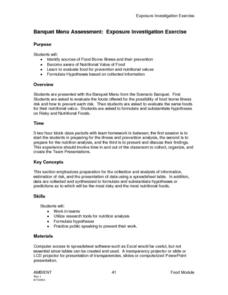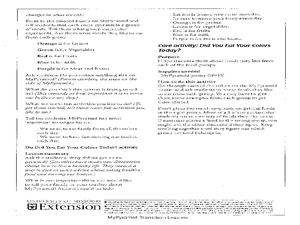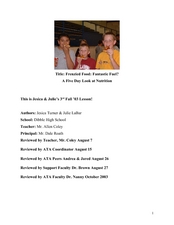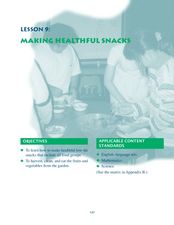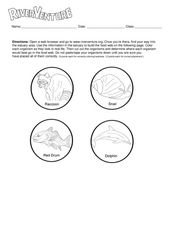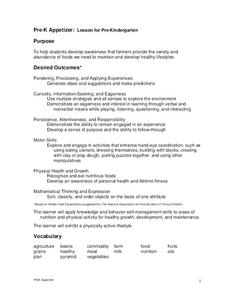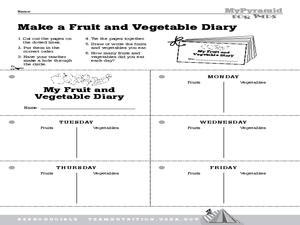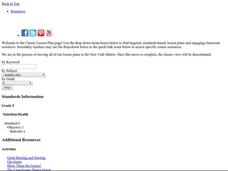Curated OER
Bugs in the Woods
Second graders identify insects and plants in the forest ecosystem in a structured field trip with stations and activity booklets. In this bugs lesson, 2nd graders explore the ecosystem of the forest, complete the booklet and play...
Curated OER
Fun Nutrition- Ice Cream in a Bag
Young scholars examine the change of matter while making ice cream. In this change of matter instructional activity, students work in groups to observe the change of matter in ice cream. Young scholars follow a recipe in order to...
Curated OER
Banquet Menu Assessment: Exposure Investigation Exercise
Students identify sources of Food Borne illness and their prevention. They formulate hypotheses based on collected information. Pupils become aware of Nutrintional value of food. Students collected data are synthesized to formulate...
Curated OER
The Human Organism
In this digestion and nutrition lesson, 3rd graders test foods to find their vitamin content. Students test for starch and fats then compare their findings on charts and oral reports. The lesson concludes with a teacher directed...
Curated OER
Chemical Energy
In this science worksheet, students read about enzymes and nutrition. Students also answer 2 comprehension questions about the reading.
Curated OER
Classroom and Laboratory Management Pre Assessment
Students will learn the meaning of food science and management for the classroom and laboratory. Background For Teachers: NOTE TO TEACHERS: A pre-assessment should never be graded. Good pre-assessment devices, however, can also be used...
Curated OER
Nutrition: Gregory the Terrible Eater
Students listen to a story about a goat who craves human food. They discover the four basic food groups and discuss what they might eat if they were terrible eaters. Students retell the story by looking at the pictures. They complete...
Curated OER
Introducing My Pyramid
Students explore MyPyramid. In this nutrition lesson, students compare and contrast MyPyramid, the new food guide from the U.S. Department of Agriculture, with the Food Guide Pyramid. Students discuss the importance of...
Curated OER
The Secret Life of a French Fry
Students explore where the food they eat comes from. In this food activity, students look at agriculture and food production. They follow the production of a french fry and discuss all the steps it goes through before being served.
Curated OER
How Do People Get Energy?
In this food energy worksheet, students will write in examples of different foods that fit into the four food groups: grains, protein, fruits and vegetables, and milk products.
Curated OER
Nutrition in Me!
Third graders explain the basic healthy eating and physical activity concepts. In this healthy lifestyles activity, 3rd graders describe two main components of a healthy lifestyle, demonstrate two different types of physical...
US Apple Association
Apples: A Class Act! (Grades Pre-K–3)
Discover the nutritional wonders of apples and get to know Johnny Appleseed with a plethora of learning experiences that cover subjects math, history, English language arts, health, and arts and crafts. Activities include an apple...
Curated OER
Healthy Body Image: A Lesson Plan for High School Students
How does your class view themselves? High schoolers explore body image through a series of four activities. Groups collaborate to examine the changes we experience as a part of growing up, how the media influences body image, and healthy...
Curated OER
Frenzied Food: Fantastic Fuel?
Students infer the causes of obesity. In this health science lesson, students brainstorm ways improve to their diet. They write personalized journals with goals on how to live a healthy lifestyle.
Curated OER
There Are Algae in Your House!
Students complete a worksheet at home stating what types of food they have at home with algae in it. They, in groups, compare with each other what they have on their worksheet.
Curated OER
Does Your Diet Stack Up?
Third graders explore nutritional variety. In this nutritional variety lesson, 3rd graders explore the many options for a healthy and well balanced diet. Students explore the food pyramid with nutritional guidelines from other countries.
Curated OER
Making Healthful Snacks
Learners examine how to make healthy snacks that include all the food groups and how to harvest, clean and eat fruits and veggies from the garden. In this healthy snack lesson students complete several activities that have to do...
Curated OER
The Nutritional Content of Food
Students are given three unknown samples and must perform two chemical tests in order to determine if the samples contains protein and/or starch. Students work with corrosive or toxic reagents.
Curated OER
River Venture
In this food web learning exercise, students color 4 animals and put them in the correct spot on a food web. They answer 3 related short answer questions.
Curated OER
Don't Forget the Bacon
Young scholars choose healthy food from different food groups. In this health lesson, students classify pictures of food into each food groups and discuss which ones are healthy. They review the food pyramid and read the story Don't...
Curated OER
Build a Burger
Second graders describe a balanced diet. In this nutrition and health lesson, 2nd graders use a hamburger to exemplify the different food groups necessary for a blanaced diet. Students use the food pyramid as a resource.
Curated OER
Pre-K Appetizer
Students understand there are healthy and not healthy food choices. In this food pyramid lesson, students learn to make healthy choices by playing a traffic light game. Students recognize raw foods from the farm may not be ready for...
Curated OER
Lesson 3: Vary Your Veggies and Focus on Fruits
Students explore fruits and vegetables. In this nutrition instructional activity, students generate a list of all known fruits and vegetables. Students cut out and compile pages for a weekly fruits and vegetable...
Curated OER
Hand Washing: I Can Handle It!
Fifth graders examine virus transmission. In this health and nutrition lesson, 5th graders explore hand washing and food handling techniques that prevent food borne illnesses. Students name viruses and the diseases caused by them


